
No one knew anything about the aye-aye, the most endangered primate in the world and a highly unusual animal with no close relatives—until Eleanor Sterling decided to change that. Find out how conservation biologists work to develop ways that humans can have a positive impact on the environment and the creatures we share Earth with.
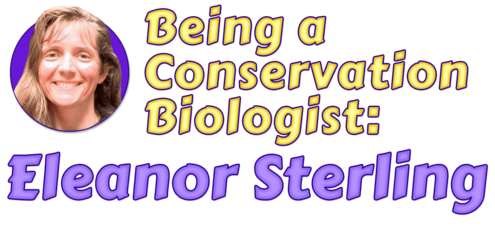
No one knew anything about the aye-aye, the most endangered primate in the world and a highly unusual animal with no close relatives—until Eleanor Sterling decided to change that. Find out how conservation biologists work to develop ways that humans can have a positive impact on the environment and the creatures we share Earth with.
1. What do you do?
Eleanor Sterling: I am the Chief Conservation Scientist at the Center for Biodiversity and Conservation at the American Museum of Natural History in New York. It's my job to find ways to make the science that happens here at the Museum useful to people involved in biodiversity all over the world. I've met with people in Vietnam, Bolivia, Madagascar , Guatemala, and Cuba .
I talk to people: government officials, university professors, park officials, people who live in or near parks. Together we look at the overall threats to their biodiversity and decide on the best places to put aside as protected areas.
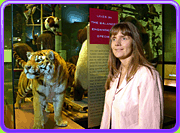
Eleanor in front of the Museum's Hall of Biodiversity
2. How did you become interested in studying languages?
Eleanor: When I was little, my dad and I went to a concert where people sang songs in different European languages. I was so impressed when he could translate all the songs for me.
It made me determined to understand other languages, and it inspired me to study French, German, and Spanish in high school. I also studied Latin, which not only helps you understand English better but is also the language of science — all scientific names of animals and plants are in Latin. In college I learned Russian and since then I've taught myself Swahili and Malagasy and I'm working with a tutor to learn Vietnamese.
Languages help you better understand how other people think and to reach out to people from other cultures. Knowing all these languages opens doors for me; people appreciate that I try to learn their language instead of expecting them to know mine.
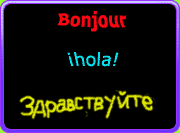
Studying different languages has helped Eleanor communicate and reach out to people.
3. So what is Biodiversity, anyway?
Eleanor: Biodiversity is the living part of the environment. It encompasses both organisms and the interactions between organisms. You can't just look at one species without thinking about the whole environment.
Do you know the story about the blindfolded man who tried to describe an elephant just by feeling its trunk? Of course, he couldn't do it without knowing about its legs, body, tail, and ears. The environment is like that: everything is interconnected, and to understand how it works, you have to consider everything in it.
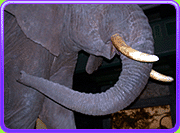
Can you describe this elephant?
4. Everything in the environment is interconnected. What does this really mean?
Eleanor: Sixty years ago, Aldo Leopold changed the way everyone thought. He said that nature was complicated and compared it to a watch that works well. At first it might seem like what you see is what's important. But it's the way the watch parts that you don't see work together that makes the whole watch work so well.
Another person who was very important, Rachel Carson, made people think about how anything we add to our environment, like pesticides, has an effect.
They're both people who changed the world by changing the way we think. Both were passionate about their work. I tell my students that they too can make a difference if they work hard and convince others with their passion and depth of knowledge.
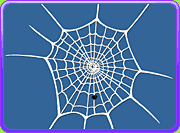
Living things depend on each other to survive. They're all connected in a web of life.
5. Did you like science in school?
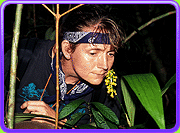
Skills learned in school help Eleanor when she's out in the field.
Eleanor: I was interested in science in school, but it always surprised me when I did well in chemistry, or math because, as a girl, I never assumed I'd do well in those subjects. I didn't mind taking science classes and learning about anatomy and chemistry but I was always more interested in the bigger picture of how animals behaved and how ecosystems worked. I realized as I got older that everything I learned in school provided me with the tools to tackle the big questions like: How can we help the environment?
6. Do you think girls who are interested in science have a harder time than boys?
Eleanor: Even today, girls face challenges. When most people think of scientists, they think of men. Women scientists in the United States are still a minority. I was very lucky when I was young. My parents, teachers, and counselors were always careful to encourage me to pursue any career that I wanted: scientist, doctor, or lawyer.
But there was one thing that was an obstacle: participating in sports. When I was a girl, the most extreme sport for girls was basketball. I wanted to run. To do this I had to join the boys' running team, but that didn't stop me. I was the only girl on the team, and boys would huff and puff trying to beat me in races. When I won, many of the boys felt badly because a girl had beaten them.
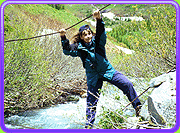
Eleanor is athletic. It comes in handy when she's working in remote places.
7. When people first meet you, are they surprised that you're a woman?
Eleanor: Sometimes, yes! They don't expect to see a woman in a position like mine; they automatically assume that people in positions of authority are men.
I never stamp my foot and act like I'm the boss. It takes patience and cultural understanding to know why people feel the way they do.
When I travel, I rely on my colleagues from other institutions to help me in these situations. But in some countries — Vietnam, for instance — many of the scientists I work with are women.
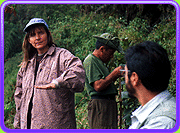
Working with people to encourage understanding and acceptance is an important part of Eleanor's work.
8. When did you first become interested in the environment?
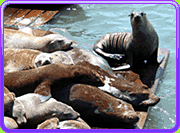
Growing up in California gave Eleanor plenty of chances to observe sea life.
Eleanor: I grew up in northern California in a neighborhood where houses had solar panels to make their own electricity. The nearby streets only had one lane to encourage people to ride bikes instead of driving their cars. I always loved animals, and my mom and dad took us to places like Monterey and Big Sur, where we'd watch the sea lions . We'd go on camping trips to a dwarf pine forest and see how the local geology affected how the trees grew.
My sixth-grade teacher was my earliest inspiration. She showed films about animals and nature and took us on field trips. After one class trip to a veal-producing farm, I became a vegetarian. The main thing this teacher taught us was that we all make choices that affect the world around us.
9. When you got older, did anyone inspire you?
Eleanor: I was majoring in language in college. To meet college requirements I went along with a friend to a physical anthropology class and had an unexpected experience that changed my life!
Nothing I'd experienced before in school had prepared me for the professor, Dr. Alison Richard. She was teaching about Madagascar and jumped up on stage to show us how a lemur goes through the forest — she acted out its movements and behavior. I was so mesmerized by this professor and her performance that I took as many classes as possible with her.
I eventually realized that this was what I wanted to do with my life: not study language but go to Madagascar and study lemurs. I feel lucky that I had such a smart teacher.
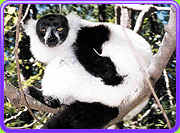
The ruffed lemur is one of the many species of lemurs that lives in Madagascar.
10. You also teach. Is this something you always wanted to do?
Eleanor: I am obsessed with reading and have been since I was a kid. I would read comics, seed catalogues, anything really, though I especially liked historical fiction and history. I was so obsessed that I brought a book to read when I went out to dinner with my family—in case the food took a long time to arrive!
I always wanted to teach. At first I wanted to teach primary school, then middle school, and then, when I got older, I wanted to teach teachers. These days I teach at Columbia University in New York, which I enjoy because students ask questions that make me think of things I hadn't thought of before. I encourage students to ask questions and to understand that there is often no single right answer to a question.

Eleanor now teaches at Columbia University
11. How did you decide what to study?
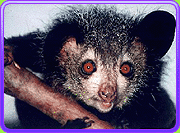
An aye-aye
Eleanor: After I finished college, I worked for the World Wildlife Fund, where I discovered that few scientists had ever studied an endangered primate from Madagascar called the aye-aye. In college, my professors used the aye-ayeas the exception to almost every rule about primates. I liked that. I became determined to go to graduate school and study the aye-aye.
So I went to Madagascar. I worked with field assistants. It took us five months to get a radio collar on an aye-aye and another month for the aye-aye to get used to us. We all played "Red Light, Green Light." The aye-aye would look at us, then look away, and we would scramble closer. The game kept up until we were near enough to watch him closely with binoculars.
12. What is so exciting about fieldwork?
Eleanor: During college I spent a lot of time at the San Diego Zoo. That's what gave me the idea of working with primates in the wild. I wrote lots of letters to people with whom I thought it would be cool to work. I got accepted as a field assistant on a project studying baboons and went to Tanzania for a year.
The most rewarding and intense adventures in my life have occurred during fieldwork. One time in Madagascar we were sitting under a tree in pitch black in the middle of the night waiting for an aye-aye to come out of its nest. Suddenly, out of nowhere, a mass of fireflies began to dance, circling round in the air. The 25-minute natural fireworks show those fireflies put on was one of the most beautiful sights I have ever seen.
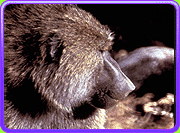
Before Eleanor studied aye-ayes she studied baboons, which are also primates.
13. Do you have any advice for kids interested in doing fieldwork?
Eleanor: I really advise anyone interested in fieldwork to try it first to make sure that it's what you want to do. Often people have a romantic idea about it, but the truth is, it isn't very glamorous.
You travel long distances to go to fairly remote places where you live in a tent and spend many hours in the freezing cold or sweltering heat waiting for an animal to do something. Sometimes it's so cold that you can't even take a sponge bath—assuming, that is, that there is enough water for one.
Though a lot of people find the experience frightening, I have to admit I find it exciting. Fieldwork is a kind of detective work that requires lots of patience.
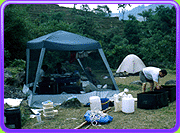
Living in a tent is something you need to get used to when you're doing fieldwork.
14. What have you discovered about aye-ayes?
Eleanor: People used to think that aye-ayes ate only insects, but they also eat fruit. We discovered their secret after I realized the aye-aye was eating something and then throwing it down from the trees.
The fruit the aye-aye eats is oval-shaped. It has an outer covering with a hard nut inside. We watched as the aye-aye used his front teeth to slice into the top of the outer covering. After he had finished with it, the top had slits all the way around, like an umbrella, and the nut was exposed. The aye-aye made a hole in the nut with his teeth and scraped out the nut meat using his third finger, throwing the rest of the fruit down from the tree on top of my head!
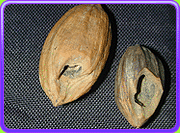
An aye-aye bit into these pieces of fruit.
15. How have your discoveries helped aye-ayes?
Eleanor: We learned that aye-ayes live in more places in Madagascar than we thought. But we still don't know exactly how many live in any one place. So the aye-aye is still listed as an endangered species.
When we figured out how aye-ayes ate, we could count how many fruits they ate in one day. Back in the lab, we analyzed their food to figure out exactly what they were eating.
We then passed this valuable information about the aye-aye's diet along to people who look after aye-ayes in captivity. Figuring all of this out was one of the most amazing discoveries of my life.
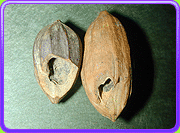
Learning about the aye-aye's diet gave Eleanor a way to help aye-ayes in captivity.
16. You've spent hours observing aye-ayes. What kind of cool tricks have you seen?
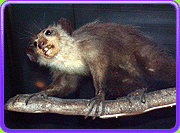
The aye-aye's long fingers and powerful teeth help it enjoy a delicious meal.
Eleanor: Once, from way up close, I watched an aye-aye tap along a log, listening carefully for echoes. When he heard an echo, he would follow the hollow section until there was no more echo.
Then he would rip that part of the log open with his teeth and scoop out an immense beetle larva. Holding it in his hand as if it were an ice cream cone, he would eat it up, licking around the outside of his hand without wasting a single drop. I never saw him eat adult beetles, only the larvae.
Another time I saw an aye-aye throwing something in the air and then tipping his head back to catch it in his mouth. The aye-aye had found a trail of ants and was flipping them into his mouth, one at a time, as if they were pieces of popcorn.
17. What kind of equipment do you use in your work?
Eleanor: We use radio collars to track animals, and, in Vietnam, we use camera traps, which send out beams of light . We put them in the forest, in the places where the animals come out at night. Animals trip the beam, and the camera takes a picture.
In Vietnam there is a beautiful bird called the crested argus. They look like peacocks, with beautiful, five-feet-long tails. We put the cameras in a depression in the forest where we thought the males would do a courtship dance.
When we came back, we discovered that all the film was used up. Imagine how excited we were when the film was developed—we had phenomenal pictures that have helped us understand the behavior patterns of this species of bird.
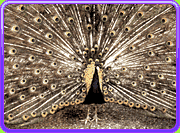
A crested argus looks a bit like a peacock.
18. How have you worked with people in Madagascar?
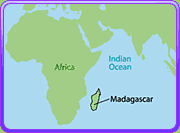
Map of Madagascar
Eleanor: I was in graduate school when I went to study the aye-aye in Madagascar. At the time, science teachers in Madagascar asked me why I didn't study the aye-aye in the U.S. They had no idea that this animal was unique to their country.
After I finished graduate school, I decided to go back to Madagascar to share what I'd learned with people there. The science in many of the textbooks was out-of-date and was not relevant to the biodiversity or culture of Madagascar. I worked as a volunteer on a project, putting together teaching materials about Madagascar wildlife and plants for teachers.
19. What can kids do to help biodiversity?
Eleanor: Think before you buy. Do you want something because you need it, or because you saw it on TV? Buy fewer things, but buy better quality so they will last longer. " Reduce, Reuse, and Recycle " is a good motto if you want to help the environment.
Do not let any of your pets loose in the wild to live. They probably will not survive, and they may threaten other plants and animals that live there too. Also, before you buy a pet, make sure it's not an endangered species. It's illegal to own endangered animals, but sometimes people in this country buy them by mistake. Make sure you're informed.
You could volunteer in a neighborhood program that helps get rid of invasive plants — plants that get out of control, take over, and push other plants out.

Remember, if you want to help the environment, "reduce, reuse and recycle."
20. Do you have to be a scientist to work on biodiversity?
Eleanor: No, you don't. All it takes is passion and determination. You could become a teacher and work in environmental education—helping people to think about the issues that affect biodiversity. Or you might consider working in a zoo, an aquarium, a botanical garden, a museum, a science center, a national park, or for organizations like the Wildlife Conservation Society or the U.S. Fish and Wildlife Service. You can learn about the kinds of things that might interest you by working on conservation projects during the summer.
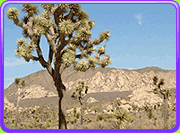
Joshua Tree National Park in California
21. How do you feel about the future?
Eleanor: I'm an optimist. You definitely have to have a positive attitude to work in this field. I think people will continue to figure out ways to live more in harmony with their environment. We'll learn how to consider our environment when we make choices about things we buy and where and how we live.
In many countries, people are becoming more aware of their natural resources. Often this is a question of survival. In this country, it's more a question of learning to want fewer of the things that harm the environment. If we all think more carefully about the way we live and the things we buy, together we can make a difference.
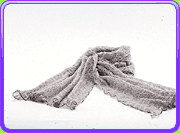
Be careful what you buy. This scarf was made from the soft coat of the endangered Tibetan Antelope .
Image Credits:
Photos: aye-aye (full body): AMNH, Hall of Biodiversity aye-aye (close-up of head): courtesy of Connie Bransilver, Duke University Primate Center aye-aye nuts: AMNH, courtesy of Eleanor Sterling baboon: courtesy of AMNH Department of Library Services, #K14396 Eleanor in front of Hall of Biodiversity: courtesy of Denis Finnin, AMNH elephant, sea lions, Columbia University, Joshua Tree National Park: AMNH Eleanor in field, Eleanor being athletic, Eleanor working with others, tent: courtesy of Center for Biodiversity and Conservation, AMNH peacock: courtesy of AMNH Department of Library Services, K15531 ruffed lemur: courtesy of Duke University Primate Center scarf: courtesy of Meg Carlough




 Biodiversity
Biodiversity
 Brain
Brain
 Genetics
Genetics
 Marine BiOLogy
Marine BiOLogy
 MicrobiOLogy
MicrobiOLogy
 PaleontOLogy
PaleontOLogy
 ZoOLogy
ZoOLogy
 AnthropOLogy
AnthropOLogy
 ArchaeOLogy
ArchaeOLogy
 Astronomy
Astronomy
 Climate Change
Climate Change
 Earth
Earth
 Physics
Physics
 Water
Water
